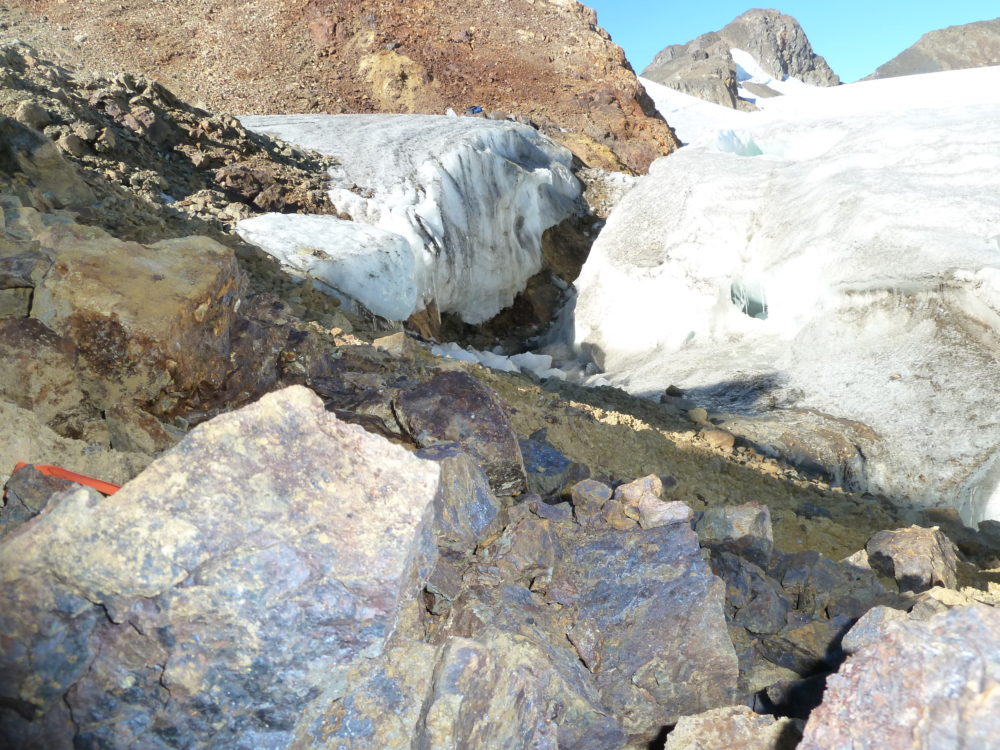AltaGas Camp, Eskay District
Northwest British Columbia flexed its muscles again this past week as GT Gold (GTT, TSX-V) more than doubled in value on additional evidence that the company has made the most significant grassroots Gold-Copper porphyry discovery in the province in many years, perhaps since Mount Milligan in the 1990’s. Keep in mind, Saddle North was never even drilled until last year, and widely spaced world class intercepts of Gold-rich porphyry mineralization are now being reported including:
- 904 m grading 0.51 g/t Au and 0.30% Cu in hole #93 (including 1.02 g/t Au, 0.51% Cu and 1.72 g/t Ag over 363.1 m)
- 494.1 m @ 0.25 g/t Au and 0.26% Cu in hole #90 (including 0.39 g/t Au, 0.39% Cu and 0.80 g/t Ag over 169.3 m)
- 822.2 m @ 0.42 g/t Au and 0.26% Cu in hole #85 (including 0.70 g/t Au, 0.41% Cu and 0.84 g/t Ag over 404.5 m)
As per last Tuesday’s news, 7 diamond drill holes have been completed in 2018 at Saddle North with results pending for 4 of them as drilling continues with 2 rigs. All 7 holes have achieved strong visual intercepts of the target mineralized monzodiorite over considerable intervals, demonstrating broad lateral and depth continuity.
Charlie Greig, VP-Exploeration for GT Gold, commented: “Porphyry discoveries of this scale and tenor are uncommon. Our exploration team is excited by the visual intercepts of sheeted vein, vein stockwork and disseminated-style Gold-Copper-Silver mineralization, and by our ability to hit the host monzodiorite intrusion in follow-up holes, even with large step-outs. It’s also exciting to know that the mineralized body is essentially intact, and largely uneroded, at surface beneath relatively thin overburden, and that it extends to depth, both downdip of our known intercepts, and along strike. We see tremendous upside for expansion and, as was the case with the nearby Red Chris deposit, potential grade increases at depth.”
The Saddle North Intrusive Complex appears to be similar lithologically to the nearby Red Chris porphyry system, but with high-potassium calc-alkalic rocks predominating.
Greig is one of B.C.’s most respected geologists who correctly predicted the high-grade Gold discovery at the adjacent Saddle South target based on extensive geochemistry that led to stunning results from first-ever drilling last year. High-grade Gold intercepts at Saddle South reported in August and September have confirmed what was suspected all along, that Saddle North is the porphyry “heat engine” driving the entire Saddle mineralized system.

The Benefits Of “Climate Change”
To the south in the Eskay Camp, Mother Nature is uncovering more Nickel-Copper-rich massive sulphide mineralization in outcrop than ever previously seen at Garibaldi Resources‘ (GGI, TSX-V) Nickel Mountain Project. One has to believe that this bodes very well for recently completed and upcoming drill holes at the Golden Triangle’s first magmatic Nickel sulphide deposit with Nickel grades in massive sulphides that are among the very best in the world.
The E&L glacier, approximately 1.6-km-long and 1-km wide and part of the Nickel Mountain gabbroic complex, is breaking up and melting north of any previously drilled holes, thanks to an unusually warm spring and summer, providing exciting new drill targets and compelling evidence that this unique deposit – open in all directions – may extend well under the untested icefield to the north and northeast.
Below is a picture taken north of the Discovery zone and northeast of the historic Northwest zone. As the ice melts, one of the most exciting discoveries in British Columbia exploration history heats up!

BMR subscribers have enjoyed market-trouncing returns through our boots-on-the-ground research and unbeatable technical and fundamental analysis of speculative niche sectors.
If you’d like to know our service better, and receive a complimentary BMR eAlert for a top opportunity as a current non–BMR subscriber, simply click on the link below and follow the simple instructions.
To read the rest of today’s Week In Review And A Look Ahead, sign up NOW or login as a current subscriber with your username and password.
Questions for us? Email us at: [email protected].

5 Comments
All I can say is “WOW” what a pic, and maybe climate change isn’t such a bad thing after all. Waiting on the Sunday Sizzler which I hope is a doozy!
Nice pics Jon. Are those massives in the photo in bedrock or loose rocks?
What you have in this area and photo, Dan1, is a combination of massive sulphides in outcrop (over at least a 30-meter length, then the massives disappear under the ice west and east), and massive sulphide boulders (float)…what a difference from a year ago or even a few months ago…this entire area was completely covered in ice when I was at the mountain in late summer/early fall last year, almost all the way to the top of the Northwest zone slope or ridge (the bottom of which you see in the foreground in front of where the glacier has ripped apart)…the melting ice is revealing beautiful massive sulphide in outcrop, never previously seen…what we know about Nickel Mountain is that wherever you have massive sulphides in outcrop, you’ll find massive sulphides at depth in drilling…drill, baby, drill!!!!!…
Are GGI rigs all at the ice cap area or do they have any still working the earlier areas? Thanks
Thanks Jon, it must have been very exciting to see those exposed massive sulphides and then for them to disappear under the ice east and west. Agree, drill baby drill!